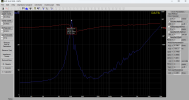rsf1977_again
Power User
Im just throwing out an idea. I'd do it myself if I could figure it out but... i cant lol. Is there anyone mathy enough to recreate the formulas discussed in a way that leaves the key variables open for users to enter their specific speaker data in order to determine the final "most accurate" parameters we should enter. I found this site that allows you to create complex custom equations and it seems like it would be possible to do here, but I don't really know. Thanks in advance if anyone figures this out 
Calc title (optional) | InstaCalc Online Calculator
Calc title (optional) | InstaCalc Online Calculator

